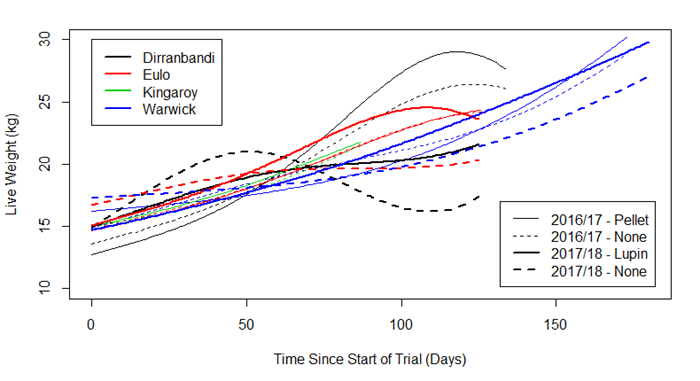Supplementing for growth
21 August 2018
Findings have been released from an MLA-supported project looking at what growth rates are achievable for young rangeland goats with and without supplementation. Among the findings were:
- rangeland goat growth rates approached 100g/day under good pastoral conditions with supplementary feed
- growth rates of +80 g/day are possible in un-supplemented goats, when conditions are favourable
- both manufactured pellets and lupins were highly desirable to goats, consumed readily and led to weight gains
- pellets flowed more easily in feeders than chopped or crushed lupins, which tended to block the feeders, therefore whole lupins are preferable to chopped lupins.
The trial has previously been reported in Goats on the Move and has now been completed.
It examined the growth rates of goats over two seasons (2016–2017 and 2017–2018). In the first season (2016–2017), 638 goats were followed for three to six months across four sites (Dirranbandi, Eulo, Kingaroy and Warwick). In the second season (2017-2018), 450 goats were followed for four to six months, spread across three sites (Dirranbandi, Eulo and Warwick).
In the trial, all goats were grazed normally, receiving normal pasture and browse. In addition, goats in half the paddocks received supplementary feed (lupins or pellets). Growth data every four to eight weeks in the trial period.
The response of lupin-fed goats was much greater than for pellet-fed goats. This is likely because the lupin trial was drought affected.
The trial also showed that males grew faster than females under all scenarios for at least the first four months (120 days).
Does it pay?
A gross margin comparison between goats, Merinos and Dorpers found the results were comparable. Growing out underweight goats is as profitable as Merino and Dorper self-replacing flocks on per hectare basis. In addition, goats have some additional benefits, such as weed control and utilisation less optimal pasture.
On a per hectare basis, Merino sheep (self-replacing, wool and meat sales) had the highest gross margins ($12.21/ha). However un-supplemented goats ($11.85/ha) and Dorpers ($10.54/ha) were close to Merinos in terms of gross margins.
Lupin supplementation of goats in drought led to larger gross margins than un-supplemented goats, albeit at small gross margin of $1.70/hectare, or a profit of $6,792/1,000 goats (cf. $1.06/Ha for un-supplemented goats). As gross margin analyses are narrowly focused, the relative benefit may even be greater, if, for example, goats can be produced as an additional enterprise on a property by using under-utilised lower quality paddocks that are suitable for goats, or to also control weeds. It is recommended that mixed farming and Merino producers consider incorporating a goat-growing enterprise to enhance whole farm profitability.
Median start and finish weights of goats in both treatment groups (supplemented and un-supplemented)
|
Trial |
Group and time |
Median weight (Q1-Q3) (kg) |
|
|
2016-2017 Commercial Pellets |
Start weight |
Supplemented |
15.1 (13.2-17.3) |
|
Un-supplemented |
14.9 (14.8-17.0) |
||
|
Finish weight |
Supplemented |
26.9 (23.9-30.4) |
|
|
Un-supplemented |
25.1(22.6-28.3) |
||
|
2017-2018 Lupins |
Start weight |
Supplemented |
16.6 (14.7-19.5) |
|
Un-supplemented |
16.8 (14.8-18.9) |
||
|
Finish weight |
Supplemented |
27.0 (23.9-31.3) |
|
|
Un-supplemented |
21.7 (19.5-24.0) |
||
Growth responses of goats to supplementary or non-supplementary feeding

Un-supplemented goats weighed less at the end of the trial than supplemented goats. The early trial data (thin lines) is for the most part found above the late trial data when drought occurred.
For further information, email project leader Dr Brendan Cowled of Ausvet.


